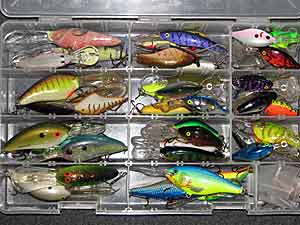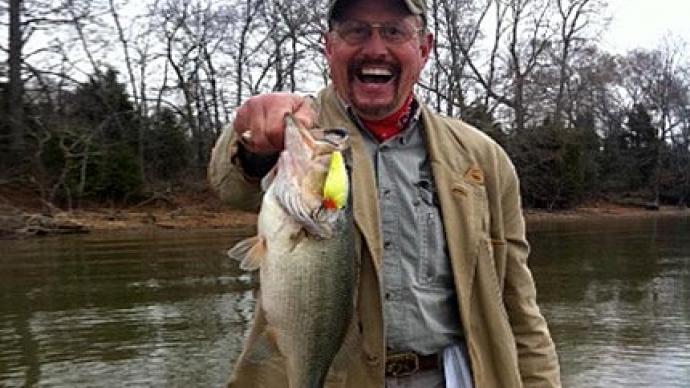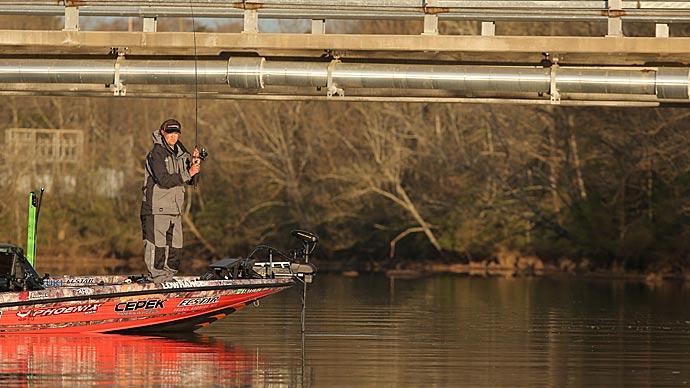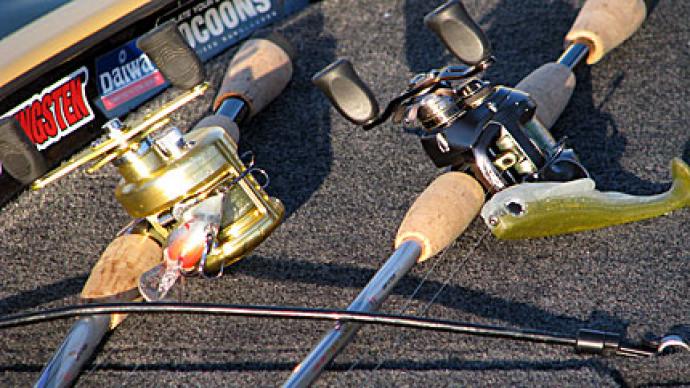
Crankbaits are among the favorite baits of professional tournament fishermen because they act as "bird dogs" in their search for bass. One of the most significant advantages of using crankbaits for bass (especially the deep-diving type) is the vast amount of water you can cover, mainly when bass use a depth of 10 to 20 feet. Crankbaits have a built-in action designed to function when the fisherman retrieves the lure steadily or "cranks" it in. They have protruding "lips" that cause them to dive beneath the surface when retrieved.
Use a light- to medium-action 7- to 7 1/2-foot rod when crankbait fishing. Softer rods will allow the bass to inhale the lure, resulting in more hooked fish, and longer rods allow longer casts and better hooksets. For best lure action and speed, use a reel with a gear ratio of 5.3:1 to 6.5:1.
Crankbaits are reaction baits - bass don't hit it because they are fooled. Instead, they hit it because something is getting away from them.
Depth
The depth at which your crankbait will run depends on many factors, including line size, lure design, and retrieve speed. Crankbaits generally run deeper when fished more slowly on lighter line with longer casts. Crankbaits with longer bills run deeper and wobble wider than lures with small bills. Use a lighter weight line for better depth control, but not too light, at least 10-pound test or better. A high stretch line is preferred because the bass will be less likely to throw the small treble hooks. Vary the depth of the bait by the height of your rod tip and speed of retrieve.
How and Where to Fish Crankbaits For Bass
Crankbaits are especially effective in the following bass situations
- Gravel, clay, or mud points and flats.
- Drop-offs and ledges of varying depths.
- Stumps and logs.
- Large rocks
Notice that crankbaits work best around "solid edges" or where wood or rocks occur. They are not well-suited to grass, moss, or weeds, although many fishermen do well by cranking them along weed edges or over the tops of submerged weed beds. Crankbaits work best as a contact lure: bump them against the bottom, knock them off stumps, etc. This will cause the bait to stop and dart erratically, causing a reaction strike. Use a crankbait with a wide lip to help eliminate hang-ups in heavy cover areas. Also, your line will touch the structure before your bait so that you will feel a slight pressure. This tells you to slow down. If they slap the bait, change something (color, size, retrieve, etc.). Smallmouth will slap baits a lot.
Try these retrieves:
| Kneel & Reel: | With a long rod, use a deep runner and stick the rod tip in the water to attain extra depth. |
| Stop & go: | Reel rapidly, then stop. Floating crankbaits will slowly rise; suspending lures will stay at that depth. Then start reeling again. Repeat. |
| Bottom bumping: | This technique is effective in both deep and shallow water. Root the crankbait along the bottom, kicking up silt and running erratically. The bait must dive deeper than the water depth to achieve this action. With practice, you can determine the bottom content from the feel of the lure. For example, a tapping on the bottom indicates rocks or gravel, a very slight drag indicates sand, and a longer tug (or a snag) indicates muck and weeds. |
| Ripping: | Crank the lure a few times to get it at the required depth and then pull back sharply with the rod, causing it to dart quickly through the water. Gather slack and repeat. |
Colors
For bass fishing, it's best to stick to basic colors. Crankbaits for bass should match in a general way the most dominant forage in the lake. Thus, popular crankbait colors that should be included in your tacklebox include silver and black(shad), green and silver (Tennessee shad), chrome (open water baitfish), orange and brown(crawfish), etc. If golden shiners occur in your waters, "match the hatch" using gold crankbaits. Fluorescent colors are effective on crankbaits in many conditions. A popular combination is a fluorescent green(chartreuse)/black spots/orange belly in stained water and cloudy days. Red works well around grass beds in clear and stained water. But remember that 80 percent of the strikes you get are due to your retrieve, not color.
Tips
- For best fish appeal, use an erratic retrieve.
- If the lure runs to the right, bend the line pull to the left, and vice-versa.
- For better sensitivity, hold your rod tip low and to the side, keeping the angle between the rod and line at about 90 degrees.
- Don't jerk hard for the hookset. Instead, reel faster - the small treble hooks can rip out on a solid hookset.
- Hook sharpness is critical with crankbaits. As a result, many professional anglers replace the standard hooks with extra-sharp, strong hooks.
- Check your line above the lure when fishing crankbaits, as rock, gravel, stumps, etc., will quickly fray your line.
- To get your lure to run deeper, try crimping a split shot 8-10 inches ahead of the bait or rig it like a Carolina rig, using a 1/2-ounce sinker.
- While lures with built-in rattles make more noise, remember that underwater, the sound lacks direction and appears to come from everywhere. Bass are as likely to strike a crankbait for their appearance as their sound.
- Use a wire cross-locking snap when fishing crankbaits, which allows you to change lures quickly and enables the bait to move more freely.
- In the early Spring, use large crankbaits. Switch to smaller baits after the spawn and progressively use larger ones as the season progresses.
- If the vibration changes, you've probably hit structure. If the bait stops vibrating, you've got a fish. Sometimes you'll lose contact with the bait.
- Loosen the drag on your reel as the bass approaches the boat.
- If feeding fish and baitfish movement are in evidence, switch from a jig or other slow-moving lure to a faster-moving crankbait for more action. But remember that crankbaits tend to catch smaller fish than jigs and worms.
- Concentrate on speed and depth control.
- Try fishing around ditches where a nice spring or summer rain is washing into the main source of water. Fish around the muddy water and sometimes through it. Select a crankbait that makes a lot of noise and has a bright color. Dark colors like Baby bass will also work. This technique helped me land my 7 lb. 12 oz. largemouth and many others.
- If you are fishing stained water and see a big black spot by the shore or in a little deeper water, it's two things: a stump and a giant bass! Cast five feet beyond it and then reel the crankbait (a shallow running one works best, or however deep the stump is, match the bait with the depth of it) so that it will deflect or hit the stump. The bass will inhale the bait.




